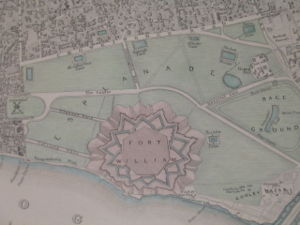Fort William: Difference between revisions
No edit summary |
Symorsebrown (talk | contribs) Add internal link |
||
| Line 9: | Line 9: | ||
==The New Fort William== | ==The New Fort William== | ||
The new Fort William was built by Robert Clive at a cost of £2,000,000 and was completed in 1773. Situated on the site known as the Maidan, it is octagonal in shape and covers an area of 2 square miles. Three sides of the fort face the Hoogly River and there are six gates. | The new Fort William was built by [[Robert Clive]] at a cost of £2,000,000 and was completed in 1773. Situated on the site known as the Maidan, it is octagonal in shape and covers an area of 2 square miles. Three sides of the fort face the Hoogly River and there are six gates. | ||
===Garrison=== | ===Garrison=== | ||
Revision as of 17:41, 20 March 2011

Fort William was the main British military garrison in Calcutta. It is still in use today as the headquarters of the Indian Army Eastern Command.
The Old Fort
Named for William III of England, the fort was completed in 1806 and was the site of the British factory at Calcutta. This fort had the guard room that became known as the Black Hole of Calcutta, where British prisoners were held after the fort was captured by the Nawab of Bengal in 1756 (see Tony Fuller's articles in FIBIS Journals 1&2).
The original fort was further north, but was relocated to the present site on the Maidan after the Battle of Plassey. The old fort would later be used as a customs house.
The New Fort William
The new Fort William was built by Robert Clive at a cost of £2,000,000 and was completed in 1773. Situated on the site known as the Maidan, it is octagonal in shape and covers an area of 2 square miles. Three sides of the fort face the Hoogly River and there are six gates.
Garrison
Two infantry regiments were stationed at the fort, one British, one native, as well as a Royal Artillery company.
Buildings
Buildings inside the fort include:
- St Peter's Church - the fort church built in 1828
- St Patrick's - Catholic Chapel built in 1857
- Military Prison
- Governor's Residence - later used as the Soldier's Institute and the Garrison School